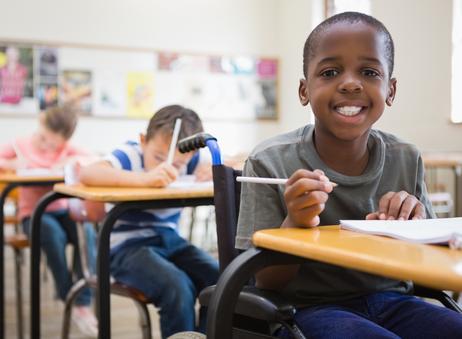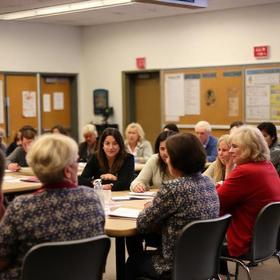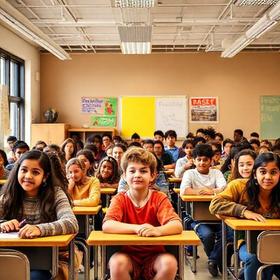When it comes to schools in the United States, the biggest differences lie in the gap between public and private school. What many people do not realize, however, is that there are many different subcategories for each.
For example, a charter school is an independently run public school that has greater flexibility than a traditional public school. Charter schools still need to meet state standards, but a significant portion of their curriculum and operation is influenced by the school’s “charter” – a performance contract that details the school’s mission, as well as the students served, specific performance goals, and its methods of assessment. As modern reform continues to shake the foundation of the United States education system, a debate about charter schools has risen to the forefront.
In theory, charter schools exist to provide underprivileged students with access to better education. The primary question, however, is whether charter schools inadvertently support segregation. Keep reading to learn more about charter schools and how they are changing the face of the U.S. education system.
Understanding the Basics Of Charter Schools
According to the National Alliance for Public Charter Schools (NAPCS), there are roughly 6,900 charter schools in the United States. Though they are technically public schools and therefore open to a wide range of students tuition-free, charter schools work differently than traditional public schools. A charter school operates under an independent contract (known as a “charter”) in front of an authority such as a government agency, university, or non-profit organization.
While a charter school is independently run and may have specific educational objectives in terms of curriculum, it must still meet district and state standards. Generally speaking, however, charter schools offer a high-quality education that not only meets but often exceeds those standards.
Each charter school is unique in its design and operation as well as the results it achieves. Though these schools must meet the same standards as other public schools, they must also uphold the promises made in their charters in addition to demonstrating adequate performance in areas of organizational stability, financial management, and academic achievement. If a charter school fails to meet performance goals, it might be shut down.
Charter schools are publicly funded but privately run. This, among other factors, has led to a certain degree of controversy among the American public. As the number of charter schools continues to increase, so does the debate surrounding these schools as an alternative option to public education. Keep reading to learn more about the debate.
In this exhaustive video from Harvard Education, leading educators, policymakers, and researchers come together to debate the charter school movement and its future.
How Do Charter Schools Get Started?
As we’ve already mentioned, there are nearly 7,000 charter schools in the United States serving somewhere around 3.1 million students. Though charter schools can be found in 43 of the 50 states, many Americans still misunderstand them. According to the results of the 2014 PDK/Gallup poll, 48% of Americans do not know that charter schools are public, and a similar percentage were under the impression that charter schools are allowed to teach religion.
School choice has become a cornerstone of the Trump administration’s education policy which has sparked a great deal of debate. But what exactly is the controversy all about?
Let’s start by taking a look at how a charter school is started.
When talking about charter schools, it is important to recognize that their very existence turns a state’s public education into a two-sector system. Traditional public schools are populated with students who live within certain boundaries and they are centrally managed. Charter schools, on the other hand, are restricted by state limits (and some city limits as well) but they attract a more diverse student body thanks to the lack of geographical boundaries – they are also independently managed.
What many people fail to understand is that chartering laws do not actually create schools – they simply enable the kind of legislation that makes it possible for individuals or groups to create charter schools. The whole idea behind the charter sector was to encourage innovation in education – to explore new ways to teach. While charter schools are independently run and therefore have a certain degree of freedom regarding curriculum, they must still adhere to their charter and to state standards – a charter school’s renewal is determined by performance.
This video offers a brief history of charter schools.
Something else to consider is that a charter must be authorized – anyone wishing to start a charter school must submit a proposal. The proposal then goes to an authorizer who approves or denies the proposal. Once the school is opened, then, the authorizer must monitor its performance and, five years later, determine whether to keep the school open or to close it. Authorizing groups are determined at the state level and, in some cases, the state itself is the only authorizer. Other authorizing agents may include non-profit organizations, universities, or local school boards.
What Students Do Charter Schools Take?
As was previously mentioned, many Americans misunderstand the basics about charter schools – they often assume that a charter school is a form of private school when it is actually a type of public school. Like traditional public schools, charter schools must accept all students. If the school receives more applicants than they have space for, they conduct a lottery.
Something you might not know is that while traditional public schools are supposed to take every student, the reality is a little bit different. Public schools must take any student who lives in the district but the location of the district itself plays a role in limiting the kind of students who will attend the school – only children of families who can afford to live in the district can send their kids to the school in that district.
Not only must charter schools take students from all over, but they must also accept kids who have disabilities as well as English language learners (ELLs). In fact, experts say that over 50% of charter school students are from black and Latino households, primarily in inner cities.
Providing underprivileged students with access to high-quality education can only be a good thing – or can it? The undertone of the charter school debate is the worry that it might be widening the racial divide in public education. Keep reading to learn more about the ongoing charter school debate.
What is the Charter School Debate All About?
According to a 2014 article published by U.S. News, the number of charter schools in the United States has been rising steadily each year. In fact, the number of charter schools in the country rose by 47% between 2006 and 2014. Even so, charter schools only represent 6% of the U.S. public school system.
Not only are new charter schools opening each and every year, but the Department of Education announced in October 2017 that $52 million in grants would be awarded for the “replication and expansion of proven charter schools and another $200 million in state grants for charter schools”. This award is the result of work that began during Obama’s administration when, in his 2010 budget plan, he asked for more awards to be given directly to nonprofits for the replication of successful charter school models. This kind of policy-making is usually reserved for authorizing committees, so it was a big deal when a bipartisan group of legislators (which included many leaders of said authorizing committees) created the grants.
Such a significant award is a big step for charter schools across the country, but the change is being met with mixed reviews. There is some concern that expanding charter schools across the nation would contribute to the widening racial gap in the public education sector.
According to an article published in The Washington Post, the nation’s educational system has become increasingly segregated by both race and class over the past two decades or so. Proponents of charter schools claim that they aim to create better schools for marginalized students but, according to some research and federal data, charter schools are actually more likely to be segregated than traditional public schools.
Deuel Ross, an attorney for the NAACP Legal Defense Fund, has been quoted saying, “research and hundreds of years of history have shown that segregated schools are not what’s best for black children”. At the same time, however, other research shows that schools serving primarily low-income children of color tend to have more inexperienced teachers and fewer resources. Charter schools, it seems, are something of a double-edged sword for the underprivileged in public education.
Do Charter Schools Really Increase Segregation?
According to the results of a 2017 analysis by The Associated Press, charter schools do indeed increase segregation within the public school system. These claims have been met with a great deal of controversy, however, and there are still those who remain steadfast in their belief that charter schools “are giving long-overdue opportunities to minority children by providing high-quality educations”.
So, what is the truth about all of this outrage? Here are a few interesting points that are worth consideration:
Residential Segregation and Racial Isolation
It may be more accurate to suggest that residential segregation is more to blame for increases in racial isolation within the public school system than charter schools themselves. Many studies make a comparison between the average racial makeup of charter schools to the average makeup of traditional public schools on a nationwide level. The truth is, however, that many charter schools are located in the inner city. Studies that compare these schools to traditional public schools in the same neighborhood find them to be only slightly higher in minority enrollment. You cannot comment on the fact that many inner-city charter schools serve primarily minority students without also mentioning that many suburban charter schools serve primarily white students. Racial isolation goes both ways.
Choice Must Be Factored In
The word “segregation” has a dark history in the United States and when Gary Orfield first called the public charter school system segregated, he used that word for its political implications. You must keep in mind, however, that the so-called “segregation” of public charter schools is very different from the nation’s history of segregation in one important way – families of minority students are actively choosing these charter schools. Bill Wilson, the first African-American to be elected to St. Paul City Council said it well, that there is a “huge difference between forcing people because of their race, to attend a school, and giving new options to people, especially those from low-income families and families of color.” What many critics fail to recognize is that minority families are actively choosing charter schools because they are the highest quality schools in the area – not because they are primarily serving minority students.
To a certain degree, protecting the right of minority families to choose is an issue of social justice. For decades, the American public school system has failed to offer low-income families the same option to choose a higher quality of education for their children as it offers to wealthy families. High-income families can choose to send their children to private school or they can move to the suburbs where the quality of education is higher. Low-income families deserve the same right to choose. There seem to be critics from every angle – the same families who are denied quality schools in their own neighborhood are being attacked for sending their children to a better school outside their neighborhood simply because the student population is primarily black.
Is Academic Success More Important than Diversity?
Another question that needs to be raised in the charter school debate is whether diversity is more important than academic success. Should a charter school that is predominantly black or Latino be criticized for being less racially diverse than another school when its students are succeeding academically? Research overwhelmingly shows that students who attend public charter schools in low-income urban areas perform much higher academically than their demographically-similar peers who attend traditional public schools in the same district. To continue ignoring the academic success of these students is to suggest that the academic achievements of predominantly minority student populations are somehow less meaningful than the academic success of white students.
Something else to consider is that even so-called “diverse” schools – schools with a greater diversity of students – can still be incredibly segregated. It is often the case with “integrated” urban schools that white students tend to enroll more frequently in honors and AP classes while minorities remain in standard classes. In contrast, the results of a 2015 study conducted by Stanford University, show that after four years attending a charter school, the average urban student received half a year more learning for each year of attendance than demographically-similar peers. All of this is to suggest that while diversity in education is certainly a goal to strive for, it should not be at the sacrifice of academic success for the nation’s underserved populations.
What Is the Takeaway?
There are valid arguments to be made on both sides of the charter school debate, but the fact remains that major change cannot happen overnight. There is no denying the fact that integration in public education is beneficial for students – students do better academically in both racially- and socioeconomically-integrated schools. They also develop a wide array of social and cognitive skills simply by interacting with people who are different from them.
In the nation’s current state, a state in which intolerance is becoming the norm, the country could use some more understanding and empathy. A nationwide integrated education system should remain the ultimate goal but, in the meantime, the academic success of disadvantaged children should not be sacrificed. Children in underserved areas deserve access to high-quality education here and now, even if the current options are anything but perfect. Charter schools and school choice offer viable paths toward reaching the goal of integrated education.
In this video, education advocate Geoffrey Canada dares the system to look at the data, think about the customers, and make systematic shifts in order to help greater numbers of kids excel.
There can be no denying that low-income students in the United States deserve access to a higher quality of education. The debate is in regard to what form that education should take. Unfortunately, nothing is simple when it comes to politics, so any major changes are going to happen slowly. The best thing any parent can do in this volatile political climate is to make the best possible choice for their children. Take the time to examine the options available to decide which would best serve your child and then make it happen.
You are your child’s strongest advocate and it may be up to you to ensure that he or she receives the quality of education any student deserves. Keep in mind that the choice that is right for your child may not be the same choice that is right for another. The more you research and understand the options, the more you will be able to make an educated decision – that is all any parent can really do.
Questions? Contact us on Facebook. @publicschoolreview














